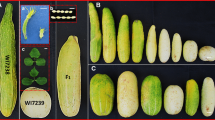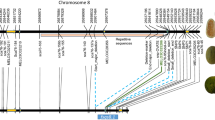Abstract
We previously identified fs10.1 as a major QTL controlling fruit shape (index of length to width) in an interspecific F2 cross of Capsicum annuum (round fruit) × C. chinense (elongated fruit) in pepper. To more precisely map and characterize the QTL, we constructed near-isogenic lines for fs10.1 and mapped it in a BC4F2 population. In this population, fs10.1 segregated as a Mendelian locus and mapped 0.3 cM away from the closest molecular marker. We further verified the effect of fs10.1 in an F2 population from an independent cross between elongated- and conical-fruited parents. To identify additional allelic variation at fruit shape loci, we screened an EMS-mutagenized population of the blocky-fruited cv. Maor and identified the mutant E-1654 with elongated fruit. This fruit shape mutation was mapped to the fs10.1 region and was determined to be allelic to the QTL. By measuring fruit shape of near-isogenic lines for fs10.1 during fruit development, we found that the shape of the fruit is determined primarily in the first 2 weeks after anthesis. Histological measurements of cell size and cell shape in pericarp sections of fruits of the isogenic lines throughout fruit development indicated that the shape of the fruit is determined primarily by cell shape and that the development of fruit shape is correlated with cell shape.





Similar content being viewed by others
References
Barchi L, Lefebvre V, Sage-Palloix AM, Lanteri S, Palloix A (2009) QTL analysis of plant development and fruit traits in pepper and performance of selective genotyping. Theor Appl Genet 118:1157–1171
Ben Chaim A, Paran I (2000) Genetic analysis of quantitative traits in pepper (Capsicum annuum). Proc Am Soc Hortic Sci 125:66–70
Ben Chaim A, Paran I, Grube R, Jahn M, van Wijk R, Peleman J (2001) QTL mapping of fruit related traits in pepper (Capsicum annuum). Theor Appl Genet 102:1016–1028
Ben Chaim A, Borovsky Y, De Jong W, Paran I (2003a) Linkage of the A locus for the presence of anthocyanin and fs10.1, a major fruit-shape QTL in pepper. Theor Appl Genet 106:889–894
Ben Chaim A, Borovsky E, Rao GU, Tanyolac B, Paran I (2003b) fs3.1: a major fruit shape QTL conserved in Capsicum. Genome 46:1–9
Canady MA, Ji Y, Chetelat RT (2006) Homeologous recombination in Solanum lycopersicoides introgression lines of cultivated tomato. Genetics 174:1775–1788
Eshbaugh WH (1993) History and exploitation of a serendipitous new crop discovery. In: Janick J, Simon JE (eds) New crops. Wiley, New York, pp 132–139
Frary A, Nesbitt TC, Frary A, Grandillo S, van der Knapp E, Cong B, Liu J, Meller J, Elber R, Alpert KB, Tanksley SD (2000) fw2.2: a quantitative trait locus key to the evolution of tomato fruit size. Science 289:85–88
Guo M, Rupe MA, Dieter JA, Zou J, Spielbauer D, Duncan KE, Howard RJ, Hou Z, Simmons CR (2010) Cell Number Regulator1 affects plant and organ size in maize: implications for crop yield enhancement and heterosis. Plant Cell 22:1057–1073
Kaiser S (1935) The factors governing shape and size in Capsicum fruits: a genetic and developmental analysis. Bull Torrey Bot Club 62:433–454
Khambanonda I (1950) Quantitative inheritance of fruit size in red pepper (Capsicum frutescens L.). Genetics 35:322–343
Ku HM, Grandillo S, Tanksley SD (2000) fs8.1, a major QTL, sets the pattern of tomato carpel shape well before anthesis. Theor Appl Genet 101:873–878
Lander ES, Green P, Abrahamson J, Barlow A, Daly MJ, Lincoln SE, Newburg L (1987) MAPMAKER: an interactive computer package for constructing primary genetic linkage maps of experimental and natural populations. Genomics 1:174–181
Liu J, Van Eck J, Cong B, Tanksley SD (2002) A new class of regulatory genes underlying the cause of pear-shaped tomato fruit. Proc Natl Acad Sci USA 99:13302–13306
Nelson CJ (1997) QGENE: software for marker-based genomic analysis and breeding. Mol Breed 3:229–235
Paran I, van der Knaap E (2007) Genetic and molecular regulation of fruit and plant domestication traits in tomato and pepper. J Exp Bot 58:3841–3852
Paran I, Borovsky Y, Naon S, Cohen O (2007) The use of induced mutations to study shoot architecture in Capsicum. Israel J Plant Sci 55:125–131
Perin C, Hagen L, Giovinazzo N, Besombes D, Dogimont C, Pitrat M (2002) Genetic control of fruit shape acts prior to anthesis in melon (Cucumis melo L.). Mol Gen Genomics 266:933–941
Perry L, Dickau R, Zarrillo S, Holst I, Pearsall DM, Piperno DR, Berman MJ, Cooke RG, Rademaker K, Ranere AJ, Raymond JS, Sandweiss DH, Scaramelli F, Tarble K, Zeidler JA (2007) Starch fossils and the domestication and dispersal of chili peppers (Capsicum spp. L.) in the Americas. Science 315:986–988
Peterson PA (1959) Linkage of fruit shape and color genes in Capsicum. Genetics 44:407–419
Prudent M, Causse M, Genard M, Tripodi P, Grandillo S, Bertin N (2009) Genetic and physiological analysis of tomato fruit weight and composition: influence of carbon availability on QTL detection. J Exp Bot 60:923–937
Rao GU, Ben Chaim A, Borovsky E, Paran I (2003) Mapping of yield-related QTLs in pepper in an interspecific cross of Capsicum annuum and C. frutescens. Theor Appl Genet 106:1457–1466
Rick CM (1969) Controlled introgression of chromosomes of Solanum pennellii into Lycopersicon esculentum: segregation and recombination. Genetics 62:753–768
Sinnott EW, Kaiser S (1934) Two types of genetic control over the development of shape. Bull Torrey Bot Club 61:1–7
Van der Knaap E, Tanksley SD (2001) Identification and characterization of a novel locus controlling early fruit development in tomato. Theor Appl Genet 103:353–358
Van der Knaap E, Sanyal A, Jackson SA, Tanksley SD (2004) High-resolution fine mapping and fluorescence in situ hybridization analysis of sun, a locus controlling tomato fruit shape, reveals a region of the tomato genome prone to DNA rearrangements. Genetics 168:2127–2140
van Eck HJ, Jacobs JME, Stam P, Ton J, Stiekema WJ, Jacobsen E (1994) Multiple alleles for tuber shape in diploid potato detected by qualitative and quantitative genetic analysis using RFLPs. Genetics 137:303–309
Wang S, Chang Y, Guo J, Chen JG (2007) Arabidopsis Ovate Family Protein 1 is a transcriptional repressor that suppresses cell elongation. Plant J 50:858–872
Xiao H, Jiang N, Schaffner E, Stockinger EJ, van der Knaap E (2008) Retrotransposon-mediated gene duplication underlies morphological variation of tomato fruit. Science 319:1527–1530
Xiao H, Radovich C, Welty N, Hsu J, Dongmei L, Meulia T, van der Knaap E (2009) Integration of tomato reproductive developmental landmarks and expression profiles, and the effect of SUN on fruit shape. BMC Plant Biol 9:49
Zhang Y (2009) Genetic analysis of potato tuber flesh pigmentation and shape. Dissertation, Cornell University
Zygier S, Ben Chaim A, Efrati A, Kaluzky G, Borovsky Y, Paran I (2005) QTL mapping of fruit size and shape in chromosomes 2 and 4 in pepper and comparison of QTL maps with tomato. Theor Appl Genet 111:437–445
Acknowledgments
We thank Mr. Saadia Nahon for his technical support. This research was supported by United States-Israel Binational Science Foundation (BSF) grant no. 2005154.
Author information
Authors and Affiliations
Corresponding author
Additional information
Communicated by G. Bryan.
Rights and permissions
About this article
Cite this article
Borovsky, Y., Paran, I. Characterization of fs10.1, a major QTL controlling fruit elongation in Capsicum . Theor Appl Genet 123, 657–665 (2011). https://doi.org/10.1007/s00122-011-1615-7
Received:
Accepted:
Published:
Issue Date:
DOI: https://doi.org/10.1007/s00122-011-1615-7




